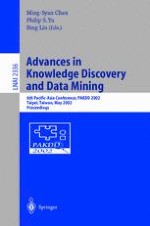Knowledge discovery and data mining have become areas of growing significance because of the recent increasing demand for KDD techniques, including those used in machine learning, databases, statistics, knowledge acquisition, data visualization, and high performance computing. In view of this, and following the success of the five previous PAKDD conferences, the sixth Pacific-Asia Conference on Knowledge Discovery and Data Mining (PAKDD 2002) aimed to provide a forum for the sharing of original research results, innovative ideas, state-of-the-art developments, and implementation experiences in knowledge discovery and data mining among researchers in academic and industrial organizations. Much work went into preparing a program of high quality. We received 128 submissions. Every paper was reviewed by 3 program committee members, and 32 were selected as regular papers and 20 were selected as short papers, representing a 25% acceptance rate for regular papers. The PAKDD 2002 program was further enhanced by two keynote speeches, delivered by Vipin Kumar from the Univ. of Minnesota and Rajeev Rastogi from AT&T. In addition, PAKDD 2002 was complemented by three tutorials, XML and data mining (by Kyuseok Shim and Surajit Chadhuri), mining customer data across various customer touchpoints at- commerce sites (by Jaideep Srivastava), and data clustering analysis, from simple groupings to scalable clustering with constraints (by Osmar Zaiane and Andrew Foss).
